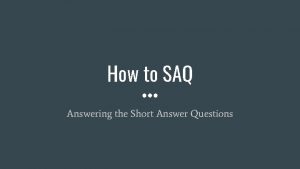Updated Information HOW TO SAQ The Short Answer








- Slides: 8

Updated Information HOW TO SAQ

The Short Answer Questions (SAQ) follow the Multiple Choice portion of the AP exam. You have 40 minutes.

The Short Answer Questions (SAQ) follow the Multiple Choice portion of the AP exam. There are 4 SAQs, and each one has 3 parts. Using the picture below, answer all parts of the question that follows A. Identify ONE way the interaction above represents the Tang Dynasty’s hegemony over neighboring states. B. Explain how the picture represents a continuity in Chinese imperial history. C. Explain on way in which the interaction between China and central Asia changed after the collapse of the Song Dynasty.

You must answer questions 1 & 2, but you have a choice of answering either question 3 or 4.

TIMING: 3 QUESTIONS x 3 PARTS (ABC) 9 THINGS TO DO 9 40 MINUTES 4: 26 PER PART

In the past, the SAQs asked you to: “Identify and explain …” or “Describe and explain …” You use the ACE strategy to answer each part.

The Big Change College board has made a subtle change in the format of the questions: Part A will ask you to: “Identify …” or “Describe …” Parts B and C will ask you to “Explain …” ACE strategy will still be helpful on parts “B” and “C. ”

Spiraling of skills Part A requires a fairly simple answer. You can probably answer with a sentence or two. Part B is more complex, asking you to explain what you know about the prompt. Part C will probably ask for higher levels of analysis, for you to compare what you know with other things that are going on. A Response B Response C Response













